
American Base Hospital No. 17 was an American military hospital formed in Detroit, Michigan. During the First World War, the hospital moved to Dijon, Department Cote D'Or, France where it was set up to deal with war casualties. [1]

American Base Hospital No. 17 was an American military hospital formed in Detroit, Michigan. During the First World War, the hospital moved to Dijon, Department Cote D'Or, France where it was set up to deal with war casualties. [1]


Base Hospital No. 17 was organized in September, 1916, at the Harper Hospital (now Harper University Hospital), Detroit, Michigan, and was mobilized there on June 28, 1917. On July 3, 1917, the organization was transferred to Allentown, Pennsylvania, leaving there July 11, for New York City, where it embarked on the SS Mongolia and sailed July 13, 1917. It arrived at Southampton, England, July 24, by way of Plymouth, England, and at Le Havre, France, July 25, 1917. It remained at Le Havre until July 28, when it proceeded by rail to its final destination, Dijon, in the advance section, arriving there July 29, 1917. [1]
Base Hospital No. 17 was the first American organization to arrive at that station, where it functioned as an independent hospital, until January 8, 1919. At Dijon, the unit was assigned the Hospital St. Ignace (French Auxiliary Hospital No. 77), then operated by the French Army. The French had about 230 patients in the hospital when the unit arrived, the evacuation of which was not completed until August 18, 1917. It began receiving American patients on August 21, 1917, but the hospital was not officially turned over to the commanding officer until September 2, 1917. [1]
In June 1918, when the capacity of the hospital proved inadequate, a French seminary was taken over at Plombières-lès-Dijon, about 3.5 miles (5.6 km) from the main hospital, and was operated as an annex. The seminary was a large stone building, of 800-bed capacity, and was used largely for convalescent and minor surgical cases. [1]
Base Hospital No. 17 ceased to function January 8, 1919. The unit sailed from Saint-Nazaire, April 14, 1919, on the USS Princess Matoika, arriving at Newport News, Virginia, April 27, 1919. It was demobilized at Camp Custer, Kalamazoo County, Michigan, May 9, 1919. [1]
Commanding Officer
Chief of Surgical Service
Chief of Medical Service
Chief Nurse
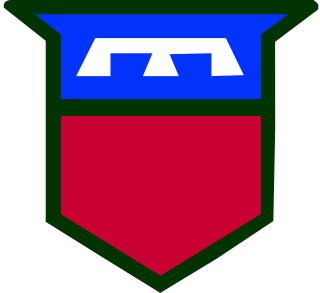
The 76th Infantry Division was a unit of the United States Army in World War I, World War II and the Cold War. The division was inactivated in 1996 and has been reconstituted as the 76th US Army Reserve Operational Response Command in 2013.

The 38th Battalion, CEF was a unit of the First World War Canadian Expeditionary Force. It was mobilized in Ottawa and recruited in Ottawa, Brockville, Perth, Prescott and Alexandria. An initial draft of five officers and 251 other ranks was sent to England on 24 June 1915. The battalion embarked at Montreal on 1 August 1915, aboard the Caledonian, disembarking in Bermuda on 12 August 1915. Its strength was 35 officers and 959 other ranks. The battalion embarked at Bermuda on 30 May 1916, aboard the Grampian, disembarking in England on 9 June 1916. Its strength was 35 officers and 1001 other ranks. The battalion arrived in France on 13 August 1916, becoming part of the 4th Canadian Division, 12th Canadian Infantry Brigade. It was later reinforced by the 7th Canadian Reserve Battalion. The battalion returned to England on 6 May 1919, arrived in Canada on 13 June 1919, was demobilized in Ottawa on 15 June 1919, and was disbanded by General Order 149 of 15 September 1920.
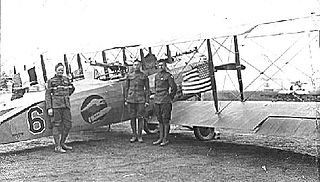
The 12th Aero Squadron was a United States Army Air Service unit that fought on the Western Front during World War I.

The 107th Fighter Squadron is a unit of the Michigan Air National Guard 127th Wing. It is assigned to Selfridge Air National Guard Base, Michigan and is equipped with the Fairchild Republic A-10 Thunderbolt II aircraft.

The 103rd Aero Squadron was an aviation pursuit squadron of the U.S. Air Service that served in combat in France during World War I. Its original complement included pilots from the disbanded Lafayette Escadrille and Lafayette Flying Corps. One of those pilots, Paul F. Baer, became the first ace of an American unit in World War I.

The 24th Aero Squadron was a United States Army Air Service unit that fought on the Western Front during World War I.

The 93d Aero Squadron was an Air Service, United States Army unit that fought on the Western Front during World War I.
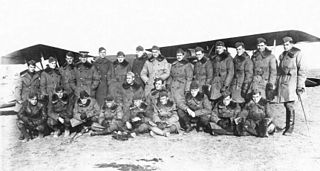
The 139th Aero Squadron was a United States Army Air Service unit that fought on the Western Front during World War I.

The 339th Infantry Regiment is an infantry regiment of the United States Army, raised for service in World War I, that served in the North Russia Intervention and World War II.

The 186th Aero Squadron was a United States Army Air Service unit that fought on the Western Front during World War I.
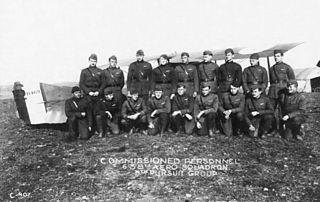
The 638th Aero Squadron was an Air Service, United States Army unit that fought on the Western Front during World War I.

The 2nd Special Operations Squadron is an Air Force Reserve Command unit, assigned to the 919th Operations Group. Stationed at Hurlburt Field, Florida, the unit operates General Atomics MQ-9 Reaper remotely piloted vehicles.

Base Hospital No. 20, located in Châtel-Guyon, France, was one of the hundreds of Base Hospitals created to treat soldiers wounded during the First World War. It was created in 1916 by the University of Pennsylvania and served the American Expeditionary Forces (A.E.F.) until 1919.

Base Hospital No. 5 was organized by Harvard University and was one of six American Expeditionary Forces (AEF) Base Hospitals loaned to the British Expeditionary Forces (BEF) during the First World War. The personnel started in Camiers at General Hospital No. 11 in June 1917 and then moved to General Hospital No. 13, at Boulogne-sur-Mer to finish out the war.

American Base Hospital No. 57 was an American military hospital formed in Georgia, United States. During the First World War the hospital moved to Paris, where a 1,800-bed hospital was set up to deal with war casualties.

American Base Hospital No. 1 was an American military hospital formed in Bellevue Hospital, New York City, United States. During the First World War the hospital moved to Vichy, France where it was set up to deal with war casualties.
American Base Hospital No. 238 was an American military hospital formed in Rimaucourt, Department Haute Marne, France. This was the last hospital to be created during the First World War.
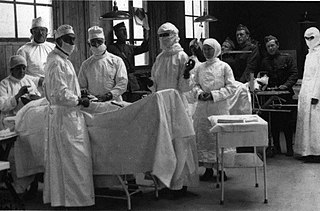
American Base Hospital No. 116 was an American military hospital formed in New York City, United States. During the First World War the hospital moved to Bazoilles-sur-Meuse, Department Vosges, in the advance section, France where it was set up to deal with war casualties.

Railway operations were originally established by the United States Army to provide support to France and Great Britain after the United States entered World War I. The Army organized and deployed different types of railway regiments and battalions. As operations progressed, the railway units were used to support the American Expeditionary Forces as well. U.S. rail regiments moved both troops and supplies for the AEF and for the allies from the seaports to the front.

American Base Hospital No. 36 was an American military hospital formed in Detroit, Michigan. During the First World War, the hospital moved to Vittel in northeastern France where it was set up to deal with war casualties.